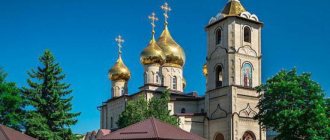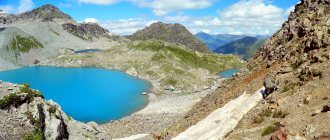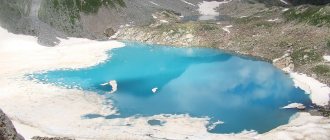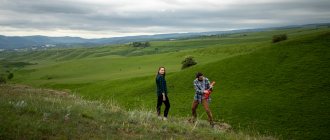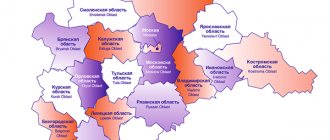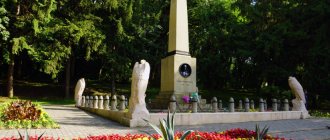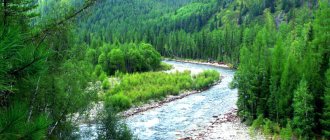What thoughts come to mind after the word “Karachay-Cherkessia”? First: the republic is somewhere in the Caucasus. Second: the Karachais and Circassians are mountain peoples who were repressed and forcibly resettled from their native territories to other regions. Third: amazing, amazing nature, mountains, sky, rivers and lakes. And fourth: delicious food and real Caucasian cuisine. All this is true, but it seems that something has been forgotten - mineral water. Perhaps everyone has heard the name “Arkhyz” at least once in their life. Arkhyz is a city in Karachay-Cherkessia, where this water is extracted, bottled in beautiful bottles and sent to stores throughout the country. But not only this type of medicinal water is mined here. There are many springs in the mountains, local residents know them and use them, perhaps even sharing their “gold” with travelers. In general, Karachay-Cherkessia is an excellent place for outdoor recreation, recreation, hiking and mountaineering. Lovers of passive pastime can also come here: numerous sanatoriums and resorts are simply ideal for homebodies and couch potatoes - you can improve your health and have a good rest. In any case, you need to go to the republic without hesitation!
What holiday is it today?
January 22, 2022, Saturday
Today are holidays, events: Day of Unification of Ukraine Tomorrow: Premiere of the opera “Eugene Onegin” at the Bolshoi Theater
Today is the Orthodox holiday: Martyr Polyeuctus. St. Philip, Metropolitan of Moscow and All Russia, wonderworker... Tomorrow: St. Gregory, Bishop of Nyssa. Venerable Markian the presbyter. Venerable Dometian, Bishop of Melitino. St. Paul of Komel, wonderworker, student of St. Sergius of Radonezh. Saint Theophan, the Recluse of Vyshensky...
Today is a national holiday: St. Philip's Day... Tomorrow: Gregory - Summer Guide...
Local government
Administration of the Prikubansky municipal district - Kavkazsky village, ave. Lenina, 26.
The structure of local government bodies of the municipality is [27]:
- The Council of the Prikubansky Municipal District is an elected representative body of the district;
- The administration of the Prikubansky municipal district is the executive and administrative body of the district;
- The head of the Prikubansky municipal district is the highest official of the district, fulfills the powers of the Chairman of the district council;
- Control and accounting body of the Prikubansky municipal district.
Head of the district administration
- Chomaev Mukhamat-Amin Ibragimovich ( from November 6, 2022
)
Head of the district, Chairman of the district council
- Botashev Mucca Soltanovich ( from September 24, 2014
)
Seasons
Seasons, four periods of the year (spring, summer, autumn and winter) characterized by certain average temperatures. The period during which the Sun passes through one of these sectors is called the season. Spring in the Northern Hemisphere and autumn in the Southern Hemisphere begin when the Sun passes through the initial circle of declination and its right ascension is 0° (vernal equinox). Summer in the Northern Hemisphere and winter in the Southern Hemisphere occur when the sun's right ascension is 90° (summer solstice). Autumn in the Northern Hemisphere and spring in the Southern Hemisphere begin when the sun's right ascension is 180° (autumnal equinox). The beginning of winter in the Northern Hemisphere and summer in the Southern Hemisphere is considered to be the winter solstice, when the direct ascension of the Sun is 270°... Next: Seasons. Russian folk calendar. Monthly words...
Trekking
Fans of hiking routes should pay attention to the river. Alikonovka, which runs along the northern slope of the Rocky Range. Both banks of the river are dotted with bizarrely shaped basalt rocks, called the “Castle of Treachery and Love.” At the foot of the mountains, in a place where basalt blocks accumulate, a tourist complex of the same name was built, consisting of two restaurants and a comfortable hotel - a pleasant bonus for participants of multi-day walking excursions. One of the tributaries of the river. Alikonovka forms a cascade of 5 waterfalls - the so-called Honey Falls. The largest of them, Bolshoi Medovy, falls down from a height of 18 m: in winter, when the stream freezes, its jets present a truly impressive sight.
Folk calendar about every day
Every day one season always replaces another and this determines a person’s way of life. In connection with this, a folk calendar was formed in which there were practically no nameless, unmarked days. Every day was special, had its own purpose. All this was determined by climate conditions and astrological phenomena.
A calendar is a system for counting periods of time. The first calendars arose a long time ago, in ancient times, because there was a need to measure time. The word calendar comes from the Latin words caleo - to proclaim and calendarium - debt book. This is due to the fact that in Ancient Rome the beginning of each month was especially proclaimed, and because it was customary to pay debts on the first day of the month. Different peoples counted time differently. Some calendars are based on the changing phases of the moon - lunar calendars; in others - the change of seasons - sunny; in others, the length of the year was coordinated with the change of seasons, and the counting of months was associated with the phases of the Moon. Such calendars are called lunisolar.
In Rus', the calendar was called a monthly calendar. Every day, the month book covered the entire year of peasant life, “describing” day by day, month after month, where each day had its own holidays or weekdays, customs and superstitions, traditions and rituals, natural signs and phenomena. The cyclical nature of the calendar is reminiscent of human life, where spring is youth, summer is heyday, autumn is the time of harvesting fruits (it’s good if there are some, otherwise you can live your life without collecting fruits), winter is the time of wisdom and peace. This cyclicality and rhythm determined the way of life of the farmer. The folk calendar was an agricultural calendar, which was reflected in the names of the months, folk signs, rituals and customs. Even the determination of the timing and duration of the seasons is associated with real climatic conditions. Hence the discrepancy between the names of the months in different areas... Next: Folk calendar...
Lake Tumanly-Kol
Trout reserve.
We continue to explore the most beautiful places in Dombay. Next up is a 2,000-year-old lake whose name translates as “foggy place.” And it is justified, because at an altitude of 1,850 meters above sea level, fogs are not uncommon.
The simplest tourist route in Dombay has been laid to the picturesque Lake Tumanly-Kel - it can be completely covered by car without any difficulty. Tourists come here to look at the trout (the second name of the lake is Trout) and feed the fish - they won’t be able to feast on it themselves: fishing is prohibited in the protected area. Daredevils can take a swim - like any glacial lake, Tumanly-Kol does not warm up well.
- Where and when: Tumanly-Kol is located in the same Teberda Nature Reserve, in the Gonachkhir Gorge. People often come to the lake in the summer; entry through the checkpoint is possible from 8.00 to 18.00, the cost of the environmental fee is 200 rubles per person and the same for a car. The nearest settlement is the village of Dombay (18 km). The distance to Cherkessk is 130 km, to Mineralnye Vody – 200 km.
Fishing calendar for every day
The fishing calendar should not be taken as an absolutely indisputable truth. Fish biting is greatly influenced by a whole range of natural factors, as well as the influence on the nature of man himself. You must not forget that the fish’s bite depends and is determined not only by the calendar dates and biological cycles of their life, reflected in the calendar, but also, no less, by the state of their habitat; the bite also depends on weather conditions: air and water temperatures, cloudiness, wind direction and strength, etc... Next: Fishing calendar...
Content
- 1 Cities of Karachay-Cherkessia
- 2 Economy of the region 2.1 Major projects
- 2.2 News about the development of the region
- 2.3 Enterprises of the region 2.3.1 Enterprises of the mechanical engineering industry
- 2.3.2 Enterprises of the fuel and energy complex
- 2.3.3 Enterprises of the chemical complex
- 2.3.4 Enterprises of the metallurgical complex
- 2.3.5 Light and textile industry enterprises
- 2.3.6 Enterprises of the timber industry complex
- 2.3.7 Construction industry enterprises
- 2.3.8 Enterprises of the agro-industrial complex
- 2.3.9 Food industry enterprises
- 2.3.10 Folk arts and crafts enterprises
- 2.3.11 Extractive industry enterprises
- 2.3.12 Other enterprises
Orthodox calendar about every day
Orthodox calendar: Orthodox, Church and Christian holidays.
The church year is an alternation of weekdays and holidays. On weekdays, a person is called to work “by the sweat of his brow to earn his bread.” Holidays are given in order to feel liberation, to rise above the bustle and routine of the world, to feel involved in the highest of worlds, “where there are no illnesses, sorrows and sighs, but endless life.” Since ancient times, holiday cycles have been associated with the seasons. The pagans associated them with the worship of the forces of nature, the cult of which in the Old Testament was replaced by gratitude to the Creator for the universe. And although the connection between holidays and the seasons has not completely lost its power, since God is present in everything, in the plant and animal world, in human works, it nevertheless faded into the background, giving way to a spiritual foundation built on the Sacred Scriptures. The history of Orthodox holidays dates back to the times of the Old Testament. Each of the Orthodox holidays is dedicated to the remembrance of the most important events in the life of Jesus Christ and the Mother of God, as well as the memory of saints... Next: Orthodox calendar...
HISTORY OF KARACHAY-CHERKESSIA
It is extremely interesting and rich in events of varying importance. The first people settled here in the early Stone Age: several sites of ancient people and samples of labor tools were found in the region. But only with the advent of the Alans (VI-VIII centuries) can we talk about the dynamics of historical development. A little later, in the 9th-10th centuries, the lands were an integral part of the Alanian state. In the 14th century they were constantly attacked by Turks and Crimean Tatars, so in the middle of the 16th century a political union was established with Russia. The country was included in imperial Russia only at the beginning of the 19th century. Cossack troops were stationed here to maintain order and guard the borders. After the abolition of serfdom in 1868, industry began to develop in the region, mainly food, and mines and mines began to operate. By the beginning of the 20th century it was relatively developed and peaceful. After the establishment of the power of the councils, significant transformations took place in Karachay-Cherkessia. Since 1918, its lands have been part of the Kuban Soviet Republic, and until 1922 they belonged to several other regions. In 1922, the Karachay-Cherkess Republic was founded, although
this administrative unit was divided several times. And in 1926, the territory was scattered into several regions: Karachay Autonomous Okrug, Cherkessk National. district and two districts - Zelenchuksky and Batalpashinsky. The first, in 1943, was still divided between the Georgian SSR, the Krasnodar Territory and the Stavropol Territory, and the local population was repressed. During the Second World War, fierce battles were fought in the region, but Hitler’s army failed to conquer the Caucasus. 1957 became a special year in the life of Karachay-Cherkessia: the Karachay-Cherkess Autonomous Okrug, which is part of the Stavropol region, was founded. This state of affairs lasted until 1991, when the region became an independent administrative-territorial unit. Attempts were made to divide it into smaller territories, but as a result of the 1992 referendum, the integrity of the republic was preserved. The modern Karachay-Cherkess Republic is an agricultural and industrial region. A significant share of the budget comes from tourism: extreme sports and resort activities are developed here.
NATURE
One can talk endlessly about the picturesque nature of the Caucasus and the regions located here; Karachay-Cherkessia is no exception to the rule. This region is located in the foothills of the Caucasus. The local climate here is very good: winters are mild and short, summers are warm and humid. If we talk about natural zones, we can distinguish several of them - forest-steppe, steppe, alpine and subalpine meadows. The flora is represented by several hundred species of herbaceous plants and shrubs. Of the former, the most common are shepherd's purse, common mullein, sage and elecampane. There are fewer shrubs, they are found mainly on dry slopes and on forest edges - barberry, rose hips, sea buckthorn, various types of ferns. The fauna of Karachay-Cherkessia is inherently unique. Here there are species that live only in this territory - the Caucasian black grouse, the Promethean vole and the Caucasian snowcock. In general, in the region you can also find more common animals - roe deer, deer, bison, gophers, hares and beavers. Naturally, there are also endangered species listed in the Red Book. The list of these includes rare species that are carefully protected, for example, in one of the areas a deer nursery has been created, where a little more than 200 individuals currently live. In Karachay-Cherkessia, there are also natural protected zones, for example, the Teberda Nature Reserve, where not only plants and animals are protected, but also soils, rocks, etc. But there are catastrophically few such structures; to preserve the natural heritage of the region, more such places need to be organized!
RESERVOIRS
There are more than 300 bodies of water in Karachay-Cherkessia: alpine lakes, ponds, rivers, streams. There are 172 rivers in the region, and the largest are Kuban and Urup, Maly and Bolshoi Zelenchuk. There are more than 130 lakes here, all of them are mainly located in the mountains. One of the most interesting specimens can be called Lake of Love, hidden in the mountains near the city of Arkhyz. The name is given to it by its shape; it looks like a heart. The water in the reservoir is very clean and transparent, and beautiful flowers grow along the banks. It is best to come here in the spring, although it is very beautiful here in the summer. There are many waterfalls in the mountains, all of them are a stunning sight: rapid streams of water fall from a great height and irrigate the entire surrounding area with their icy spray. Very often you can see a rainbow here, and it is lucky. One of the most picturesque waterfalls is Alibeksky. It is located in the gorge of the same name, on the territory of the Dombay glade. The giant is interesting because it does not fall vertically, but rushes its waters along the mountain slopes. The spectacle is amazing: foamy waves, small splashes, a seething stream, all this personifies the power and strength of the elements. In addition to natural reservoirs, there are also artificial ones in the republic - the Kuban reservoir and the system of the Great Stavropol Canal supply water to the lands of the republic and Stavropol region. In other words, there is no shortage of water in Karachay-Cherkessia!
Russian folk calendar for every day
The word “sign” comes from the word “notice”, i.e. observe. As a result of observing what happens around a person every day, he accumulates life experience. This knowledge was passed down from generation to generation, carefully preserved and people trusted it as a sacred book. Many signs have come to us from the depths of centuries without losing their knowledge. Each of us is free to choose: to dismiss all this as an absurd superstition or to take a closer look at the signs and take the centuries-old experience of generations more seriously. Most of us, when taking exams, ask them to scold them, boasting about some kind of good fortune or luck, spit so as not to jinx them or knock on wood, take a detour if a black cat crossed the road, are afraid of the number 13 and much more. And who among us does not have lucky things, numbers? Who has never resorted to the help of fate at least once in their life, who has not believed in secrets? It’s as if everything connected with signs is hidden somewhere deep in our subconscious. Often we remember them mechanically, unconsciously, or just as a joke. But, undoubtedly, the signs contain a lot of accurate knowledge and practical wisdom of our ancestors. They cover all the characteristic, often difficult to perceive, natural phenomena. Signs have preserved a lot of what was in old folk holidays and customs; they help predict the weather, grow crops... Next: Folk signs...
Holiday calendar, dates and events of the year
All state and professional holidays in Russia, including significant World and International holidays, and other equally interesting holidays and events about every day.
The holiday has always kept pace with the history of mankind. Social time can be divided into three types: everyday life (weekdays), weekends and holidays. Everyday life is a series of practices repeated day after day and every day (work). Weekends are regular breaks from the rush of everyday life. It is believed that on weekends a person should restore his strength after working days. Day off, non-working day. A holiday is a day of celebration established in honor or in memory of someone or something. A day or series of days celebrated by the church in memory of a religious event or saint... Next: Calendar...
Prayer book, Orthodox prayers for every day
Prayer is the most powerful means for healing all illnesses - both physical and mental. Prayers can be laudatory or grateful, petitionary and repentant. If we have offended God, sinned, we must ask Him for forgiveness, that is, repent. Such prayers are called repentant prayers. If everything is fine with us, if we and our loved ones are healthy and prosperous, if we have a place to live, something to wear, something to eat, we must glorify and thank God for this. Such prayers are called praise or thanksgiving. If some misfortune, illness, trouble or need happens, you need to ask God for help. Such prayers are called petitionary... Next: Orthodox prayers...
Zodiac, astrological, eastern calendar. Zodiac signs
In ancient times, to establish the calendar, priests used knowledge of the positions of all the planets. Before the reform of Peter 1, the New Year was celebrated on the Day of the Autumn Equinox. On this day, according to ancient legend, the most peaceful treaty was concluded between the Great Race (ancient Slavs) and the Great Dragon (ancient Chinese) and it was approximately 7518 years ago... For the ancient Slavs, the calendar month corresponded to the lunar cycle from new moon to new moon, taking into account such Thus, the relationship of the entire annual cycle with astronomical and natural phenomena. There was no coherent calendar system. The main natural phenomena are still considered to this day to be the days of the solar equinox and solstice - the Slavic holidays Maslenitsa, Kupala, Ovsen and Kolyada. But during the time of Peter 1, all ancient Slavic calendars were abolished and a new Western European calendar from the Nativity of Christ (Julian calendar) was introduced, while the beginning of the calendar was moved to January 1. The Julian calendar (old style) did not take leap days into account and accumulated one extra day every 128 years. After the October Revolution in 1918, the Gregorian calendar (new style) was introduced in Russia, according to which an amendment of 13 days was introduced. The calendar of the ancient Slavs was based on two planets: the Sun and the Moon. And now they don’t use anything at all. The calendar has become static. There is no such thing as the calendar, it turns out, resting on some planet. Nobody even knows about it. There are just some standard numbers, there are months and holidays. The calendar is based on the Sun and Moon. Why is this so? Because these two luminaries influence the Earth. The Earth revolves around the Sun, and the Moon revolves around the Earth. And these two luminaries create the atmosphere on the planet. From here the calendar is built... Next: Astrological calendar...
CITIES OF KARACHAY-CHERKESSIA
Karachay-Cherkessia is far from the largest region within the Russian Federation, but rather one of the smallest. A distinctive feature of this republic is its settlements. Surely everyone now thought that they were very large and important. In fact, this is not true. There are only four cities in the republic, the rest of the settlements have the status of villages, towns, and hamlets. But the Karachay-Cherkessian cities are very modern, and as a result, spending your holidays here is a pleasure!
CHERKESSK - the capital of the republic
Railway station: - address: Station Square, 1; — phone: +7 (87822) 4-28-87. Bus station: — address: Privokzalnaya street, 1; - telephones;
Cherkessk is the largest city in the republic both in terms of area and population; it is also the administrative center. center of Karachay-Cherkessia. The largest settlement is located in the foothills, the landscapes here are amazing. Cherkessk is a relatively young city, it was built in 1825 and was originally the village of Batalpashinskaya. It arose at the location of the redoubt of the same name, which was named after the Russian troops over the army of the Turkish commander Batal Pasha in 1790. It’s a paradox, but the village is named after the vanquished. The settlement of the town did not take place immediately; over the course of several years, Cossacks from neighboring regions (soldiers of the Kuban and Khoper regiments) moved here. Initially, Batalpashinskaya was considered a military settlement, but over time it began to play a significant role in establishing cultural and trade ties with the highlanders. In the second half of the 19th century, the village became a district town in the Kuban province, where two schools and a hospital functioned. It developed through the livestock trade, grain trade, and lumber industry. The beginning of the 20th century turned out to be a turning point. With the start of the Civil War, the city was in the hands of white troops until 1920. And in 1922, the village received the status of an administrative center, first of the Karachay-Cherkess Autonomous Okrug, then of the Circassian National. district, and then the Circassian Autonomous Okrug. The status of a city and the name Batalpashinsk were assigned to the village in 1931. In 1934, it began to be called Sulimov in honor of the head of the Council of People's Commissars of the RSFSR D.E. Sulimova. However, after the arrest of the said party leader, the city was renamed again - it became Yezhovo-Cherkessk, again in honor of the political associate of those years - N.I. Yezhova. When the leader was shot in 1939, the city began to be called Cherkessk. In 1957, it became the main settlement of the Karachay-Cherkess Autonomous Okrug, and since 1991 - the newly formed republic. Today Cherkessk is not such a prominent settlement; the basis of the economy here is small trade and several light and food industry enterprises. Cherkessk is an unusually beautiful city. And although there are not many attractions in the traditional sense of the word, there are still interesting places to visit. First of all, one cannot help but notice the amazing nature: the city is located in the foothills of the Caucasus on the Kuban River, whose banks are also distinguished by their extraordinary beauty and picturesqueness. You can admire the hills almost anywhere in the capital, but it’s better to travel beyond its borders. 18 km from Cherkessk are the Batalpashinsky lakes, now a reservoir called the Circassian Sea. It is also very, very beautiful here. Inspired by the beautiful nature, you can explore the local attractions. First of all, you need to go to the central square of V.I. Lenina, she is the oldest in the city, she has been the main one for many years. It is famous for the fact that the first monument to the leader of the revolution, V.I., was erected here. Lenin. At first the sculpture was wooden, but now it is bronze - it was erected in 1969. Then you can go to the square named after. Kirov and look at the monument to Ya.V. Balakhonov (a WWII participant) and the eternal flame. You should definitely visit the Green Island recreation park; it is one of the largest in Russia, but it opened only in 2013. Before that time, it was in ruins, and the vast territory was simply empty. Now it’s very cozy here: the trees create a pleasant shade, the benches invite you to relax, and the cheerfully murmuring fountains create an atmosphere of happiness and well-being. But fountains are not the only bodies of water here; there are several ponds and artificial canals in the park. There is even a beach area on the “Green Island” - clean and comfortable. In general, both adults and children will like it here. Everyone will like Cherkessk mainly due to the local nature. But the traditional national flavor also plays an important role in the charm of visiting tourists!
KARACHAYEVSK - the city of three rivers
How to get there: — by bus: direct or transit (to Teberda) flights; — by car: in a south-west direction 58 km (1 hour on the road). Karachaevsk is one of the most interesting cities not only in Karachay-Cherkessia, but throughout Russia. Firstly, it stands on three rivers - Kuban, Teberda and Mara. Secondly, from a bird's eye view it looks like a horseshoe, since it is located in the valleys of two out of three rivers. Well, the importance of the city is the transport hub of the republic, since it is located in the center of the high mountain regions. Karachaevsk is a young city, it was founded only in 1927, and was originally called the village of Georgievskoye. A year later it was renamed Mikoyan-Shahar in honor of A.I. Mikoyan. In 1944, it changed its name again, became known as Klukhori and became part of the Georgian Autonomous Soviet Socialist Republic (at the time of the deportation of the Karachais). It received its modern name only in 1957. Today Karachaevsk is a provincial town with a fairly developed industry, mainly light and food industry. At first glance, it may seem that the settlement is boring and uninteresting. But this opinion is fundamentally wrong. Tourists are usually recommended to start exploring Karachaevsk from the Cathedral Mosque. This building is quite young, it was erected in 2007, but it quickly became one of the iconic attractions. Externally, the Muslim temple is very light and elegant, it has two minarets and a golden dome in the middle: traditional and at the same time colorful. The mosque fits very well into the appearance of the entire city. Next you can visit an Orthodox church - the Church of the Holy Trinity (the only one in Karachaevsk). Then it is advisable to simply walk along the streets of the city and look at two iconic monuments: one is the monument to Kurman-Ali Kurdzhiev (the founder of the city), the second is the “Mountain Woman” memorial sign. “Goryanka” is perhaps the main monument of the city. Initially, it was erected as a monument welcoming guests, but over time it became the “heart” of Karachaevsk.
After exploring the city, you can go beyond its borders. Why? Because it is amazingly beautiful there and you can visit natural monuments and more! First of all, you need to find two temples - Shaoninsky and Sentinsky. They were built in the 10th century and belonged to Christians. Now the buildings, of course, are in a rather deplorable state, but the charming atmosphere of the place still remains. Both temple complexes are located high in the mountains, getting to them is problematic, but it’s worth it. Local residents will definitely recommend visiting the Devil's Wells. The name is alarming, but there is nothing scary there. “Devil's Wells” are located in the Karachaevsky district near the village of Kamennomostsky, they are a unique natural structure: the Kuban River made its way into the rock, and over time, depressions were formed here from the washing out of the rock - they are called wells. In some places there are tiers of such washed out areas. On the one hand, the spectacle is creepy, on the other - exciting! Where else can you see such an amazing natural structure? In general, absolutely everyone will like Karachaevsk: rivers and mountains always create amazingly beautiful and unusual combinations!
TEBERDA - resort city of Karachay-Cherkessia
How to get there: — by bus: direct flights; — by car: in a south-west direction 102 km (2 hours on the road). Few people know about a city like Teberda, but this is one of the health resorts in Russia and is considered a resort city. Teberda is also a relatively young city, like Cherkessk. But it arose a little earlier, in 1868, as a Karachai village. At first it was called by the name of the family that settled here, but when other families began to come here, they decided to change the name. Well, Teberda received the status of a city very late, already in the 20th century, in 1971. Outwardly, the city does not fit with traditional ideas about this type of settlement. Teberda more closely resembles a large village: the houses are mostly one-story, rarely two. But it is very cozy and calm here, the healing air is very good for health. The settlement lives mainly on income from tourism: mountaineering trips and hiking tours are organized here. Ski lovers will also be happy to be in this place; excellent ski slopes are equipped for them. There are also a balneological hospital and several sanatoriums. The cultural and educational component is also present in Teberda. There is a small local history museum here, if you want, you can go. But it’s still better to go on an exciting trip around the area. The first thing you will encounter on the way is the Sentinsky Temple, which is very ancient, but the date of its construction is not known for certain. However, the wall frescoes are dated by researchers to the 11th century, so it is quite possible to attribute the construction of the sacred structure to this time. The temple is comfortably located on the spur of a mountain range; outwardly it repeats the shape of the first Christian cross-domed churches and cathedrals. There used to be a monastery here, and even a mausoleum has been preserved on the territory. Although to say “even” is somewhat insulting to this building, it is very well preserved, happily welcoming its guests. Next, you should definitely visit the ruins of the Meuse - this city was for a long time the capital of the Alanian state, destroyed by the Mongols. It was located nearby on the right bank of the Bolshoy Zelenchuk River; this position was extremely convenient in conditions of turbulent times. Well, now it enhances the effect of the picturesque ruins; against the backdrop of water and lush vegetation they look simply breathtaking. Many people will like Teberda! Firstly, the atmosphere of the resort town cannot but charge you with positive emotions. Secondly, clean air and pristine nature untouched by man are the best way to heal people exhausted by city life.
ZELENCHUKSKAYA STANISH - small, but very interesting!
How to get there: — by bus: direct or transit (to Maykop, Pregradnaya, Moscow) flights; — by car: in a south-west direction 68 km (1 hour on the road). Zelenchukskaya is not a city, but a village, despite this, it is the regional center of Zelenchuksky district. This settlement was founded in 1859; it included the land of Storozhovaya and Kardonikskaya villages. It was needed to protect the surrounding territories from attacks by unfriendly Circassians. Any outstanding events in the life of the locality during the 19th-20th centuries. didn't happen. The only thing is that it was periodically transferred to different administrative-territorial units, but for the longest time it was part of the Kuban region. Now few people know about the village of Zelenchukskaya, but you can spend a useful holiday here. Not far from it is the Nizhne-Arkhyz settlement - a monument of Alan culture of the 10th-12th centuries. Nowadays the Karachay-Cherkessian Historical, Cultural and Natural Museum-Reserve is located on this territory.
Its area is slightly more than 90 hectares. There are several interesting places within the walls of the complex. Perhaps the most valuable exhibits of the attraction can be called the Zelenchuk temples; there are only three of them - Northern, Middle and Southern. All of them were built around the 9th-10th centuries. and are amazing examples of cross-domed architecture. The northern temple was erected in honor of St. Nicholas the Wonderworker, it was preserved rather poorly, the frescoes and paintings were not preserved at all, but the layout can be traced. The middle one was restored at the end of the 19th century by the monks of the Alexander Nevsky Monastery formed on the territory of the ancient settlement. Divine services were held in the restored sacred building. The southern temple is the only one now functioning, consecrated in 1991, called Ilyinsky. In addition to the temple complexes, the remains of fortress walls, watch bastions and destroyed buildings for utility purposes have been preserved on the territory of the settlement. Another significant object of the Zelenchuk village is the RATAN-600 radio telescope. It is considered the world's largest telescope with a reflecting mirror, the diameter of which reaches 600 m, thanks to which it can distinguish even the smallest space objects. If, after all, local attractions do not impress picky tourists, then Zelenchukskaya can offer a trip to the local natural beauties, and they certainly will not leave anyone indifferent!
UCHKEKEN - “three bushes”
How to get there: — by bus: with a change in Mineralnye Vody or in Pyatigorsk; — by car: in a southeast direction 74 km (1 hour 15 minutes on the way). Uchkeken is a small village located approximately 74 km from the administrative center; its name translates as “three bushes”. The first settlement was formed here immediately after the establishment of Soviet power: peasants from surrounding villages received permission to populate these lands. Over the course of two years, the settlement has expanded significantly geographically, and accordingly, the number of residents has also increased. A school opened here, then a club, then the first telephone line was installed - in general, life got better. Naturally, there can be no talk of industry in the village, but the agricultural component played an important role. Even during the Second World War and immediately after its end, the local population managed to reap good harvests. The village flourished in the 70s and 80s. XX century, but now Uchkeken, although it has slowed down production, still continues to develop steadily. People come to Uchkeken to see unique natural monuments. First of all, visitors are interested in Honey Falls. There are 5 of them in total - Zhemchuzhny, Hidden, Noisy (Devil's Mill), Bolshoy Medovy and Maly Medovy. These wonderful natural sculptures were called honey because in ancient times bees lived in the rocks. Today, the waterfalls are one of the most popular tourist places; all conditions for a comfortable stay have been created here - a restaurant, a tourist center and even an ethnographic museum. You should definitely visit Mount Rome, which looks more like a high hill with a cut off top. In fact, it is really a hill consisting of rocks. But in ancient times there was a settlement on it; in the Middle Ages, a large Alan city was located here, which was located on the Trans-Caucasian Silk Road and played an important trade and economic importance. Now, the remains of buildings and fortifications, for example, steps on one side of the mountain leading to its top, will help you understand that there was a fortress here. In addition, from the top there is a stunning view of the surrounding areas.
Karachay-Cherkessia is, first of all, a unique nature, unusually beautiful picturesque natural monuments. You need to come here precisely for the beauty of the surrounding world, and along the way, acquire some knowledge about the history and culture of the region as a whole!
Dream books online, interpretation of dreams
A dream book is nothing more than an interpreter of dreams and dreams, a translator of dreams. Since ancient times, people have been using dream books; dreams have always been given great importance, and people have often noticed the prophetic properties of some dreams. The dream book can become your faithful assistant every day and throughout your life, thanks to the dream interpreter you can always make the right decisions, the dream book will help you resist temptations in time, and will warn you against wrong steps and frivolous actions. Further…
